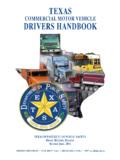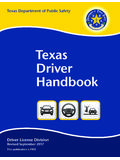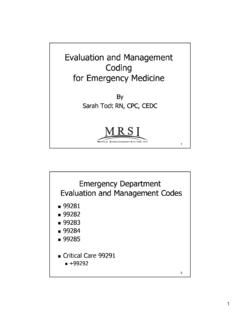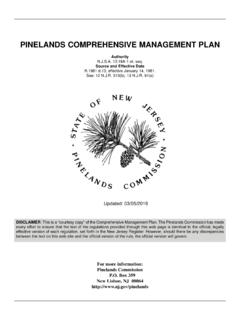Transcription of TEXAS EMERGENCY MANAGEMENT Executive Guide
1 TEXAS EMERGENCY MANAGEMENT . Executive Guide TEXAS DEPARTMENT OF PUBLIC SAFETY. TEXAS DIVISION OF EMERGENCY MANAGEMENT . TABLE OF CONTENTS. 1 Disasters vs. Emergencies 2 EMERGENCY MANAGEMENT Mission Areas Prevention Protection Mitigation Response Recovery 4 National Planning Frameworks 7 What do I need to know? Local Authority Local Plans Revision and Update Requirements 9 Disaster Assistance Requests Why declare a disaster? Requests for Response Assistance Local Steps to Declaring a Disaster What are the Requirements for a Federal Disaster Declaration? Sample Local Disaster Declaration EMERGENCY Declarations in TEXAS 19 TEXAS EMERGENCY MANAGEMENT Planning Local Planning Standards, Documents and Guidelines State of TEXAS EMERGENCY MANAGEMENT Plan EMERGENCY Support Functions Training Exercise 22 TEXAS EMERGENCY MANAGEMENT Disaster District Committees District Coordinators State Coordinators TEXAS EMERGENCY MANAGEMENT Council Jack Colley State Operations Center 24 EMERGENCY Operations Level IV Normal Conditions Level III Increased Readiness Conditions Level II Escalated Response Conditions Level I EMERGENCY Conditions 29 Federal Disaster Assistance Declaration Process Preliminary Damage Assessments Declaration Types Post Declaration Actions TABLE OF CONTENTS.
2 32 FEMA Disaster Assistance Programs Public Assistance Individual Assistance Hazard Mitigation Grant Program Fire MANAGEMENT Assistance Grants 37 Other Disaster Assistance Programs Small Business Administration Rural Community Development Block Grants TEXAS Department of Agriculture Community Development Block Grants General Land Office Home Program General Land Office TEXAS Water Development Board 39 Summary Acknowledgments 41 Appendix A: State Regions Map 42 Appendix B: State Disaster District Map 43 Appendix C: TEXAS District Contacts 50 Appendix D: FEMA Public Assistance Threshold Amounts by County 53 Appendix E: TEXAS Government Code, Chapter 418: EMERGENCY MANAGEMENT 87 Appendix F: TEXAS Government Code, Chapter 421: Homeland Security 99 Appendix G: TEXAS Administrative Code 110 Appendix H: Gubernatorial Executive Orders TEXAS EMERGENCY MANAGEMENT . Executive Guide Revised 5/1/2017. W. NIM KIDD, MPA, CEM , TEM . ASSISTANT DIRECTOR, TEXAS DEPARTMENT OF PUBLIC SAFETY.
3 CHIEF, TEXAS DIVISION OF EMERGENCY MANAGEMENT . Dear Partners in EMERGENCY MANAGEMENT : No state is more diverse in its climate, geography, culture, industry, and commerce than TEXAS . As a native Texan, I have a special appreciation for this diversity. As an EMERGENCY manager, I. also recognize the unique challenges this diversity presents in preparing for and responding to disasters and emergencies. As a career firefighter and local EMERGENCY manager, I believe in and abide by the premise that every disaster is a local disaster. It is at the local level that the greatest challenges are faced and the toughest decisions are made, and I am grateful that you have chosen to assume this challenging but rewarding role. The TEXAS Division of EMERGENCY MANAGEMENT (TDEM) is charged with carrying out a comprehensive , all-hazards EMERGENCY MANAGEMENT program for the state and for assisting cities, counties and state agencies in planning and implementing their EMERGENCY MANAGEMENT programs.
4 As part of that effort, this Guide has been developed as a resource for executives who are tasked with providing for the safety and security of their respective communities. It is my hope you find it to be a beneficial tool. This Guide is a living document and resource. We look forward to your comments and suggestions for improvement to this document and our delivery of service to you, our customer. Thank you for your service to your community and the state of TEXAS . Please contact TDEM to let us know how we may be of assistance to you. Sincerely, W. Nim Kidd, MPA, CEM , TEM . EMERGENCY MANAGEMENT What is the difference between an framework to help communities reduce EMERGENCY and a disaster? vulnerabilities to threats and hazards and cope with disasters. As defined by the Federal EMERGENCY MANAGEMENT Agency (FEMA), an EMERGENCY is EMERGENCY MANAGEMENT is an essential role of any occasion or instance--such as a hurricane, government. The Constitution tasks the states tornado, storm, flood, tidal wave, tsunami, with responsibility for public health and earthquake, volcanic eruption, landslide, safety hence, they are responsible for public mudslide, snowstorm, fire, explosion, nuclear risks, while the federal government's ultimate accident, or any other natural or man-made obligation is to help when state, local, or catastrophe--that warrants action to save lives individual entities are overwhelmed.
5 And to protect property, public health, and safety FEMA defines the overall goals of EMERGENCY MANAGEMENT at all levels as: As defined in TEXAS Government Code Chapter , a DISASTER is the occurrence or Reduce loss of life imminent threat of widespread or severe Minimize property loss and damage to damage, injury or loss of life or property the environment resulting from any natural or man-made cause, Protect jurisdictions from all threats and including fire, flood, earthquake, wind, storm, hazards wave action, oil spill or other water contamination, volcanic activity, epidemic, air National Preparedness Goal contamination, blight, drought, infestation, explosion, riot, hostile military or paramilitary A secure and resilient nation with the action, extreme heat, other public calamity capabilities required across the whole requiring EMERGENCY action or energy community to prevent, protect against, mitigate, EMERGENCY . respond to, and recover from the threats and hazards that pose the greatest risk.
6 What is EMERGENCY MANAGEMENT ? These risks include events such as natural EMERGENCY MANAGEMENT is the discipline of disasters, disease pandemics, chemical spills and dealing with and avoiding risks, particularly other manmade hazards, terrorist attacks and those that have catastrophic consequences for cyberattacks. communities, regions, or entire countries. It is the dynamic process of preparing for, mitigating, responding to and recovering from an EMERGENCY . Planning, though critical, is not the only component. Training, conducting drills, testing equipment and coordinating activities with communities are other important functions. Effective EMERGENCY MANAGEMENT relies on the integration of EMERGENCY plans at all levels of government and non-government, including individuals and community organizations. Throughout our nation's history, communities have always bonded together when disaster strikes. EMERGENCY MANAGEMENT simply creates a 1. PREVENTION. MITIGATION PROTECTION.
7 RECOVERY RESPONSE. EMERGENCY MANAGEMENT Mission Intelligence and Information Sharing Interdiction and Disruption Areas Screening, Search, and Detection The National Preparedness Goal identifies five Protection mission areas, in which it groups 32 core Protection includes the capabilities to safeguard capabilities (the distinct critical elements needed the homeland against acts of terrorism and to achieve the goal). The 32 core capabilities man-made or natural disasters. It focuses on identified in the National Preparedness Goal are actions to protect our people, our vital interests, intended to assist everyone who has a role in and our way of life. achieving all of the elements in the goal. Protection Core Capabilities: These capabilities are referenced in many Planning national preparedness efforts, including the Public Information and Warning National Planning Frameworks. Some fall into Operational Coordination only one mission area, while some others apply Access Control and Identity Verification to several mission areas.
8 Cybersecurity Intelligence and Information Sharing Prevention Interdiction and Disruption Prevention includes those capabilities necessary Physical Protective Measures to avoid, prevent, or stop a threatened or actual Risk MANAGEMENT for Protection act of terrorism. Unlike other mission areas, Programs and Activities which are all-hazards by design, Prevention core Screening, Search, and Detection capabilities are focused specifically on imminent Supply Chain Integrity and Security terrorist threats, including ongoing attacks or stopping imminent follow-on attacks. Prevention Core Capabilities: Planning Public Information and Warning Operational Coordination Forensics and Attribution 2. Mitigation Mass Care Services Mitigation includes those capabilities necessary Mass Search and Rescue Operations to reduce loss of life and property by lessening On-Scene Security, Protection, and Law the impact of disasters. It is focused on the Enforcement premise that individuals, the private and Operational Communications nonprofit sectors, communities, critical Public Health, Healthcare, and Medical infrastructure, and the nation as a whole are Services made more resilient when the consequences and Situational Assessment impacts, the duration, and the financial and human costs to respond to and recover from Recovery adverse incidents are all reduced.
9 Recovery includes those capabilities necessary to assist communities affected by an incident to Mitigation Core Capabilities: recover effectively. Support for recovery ensures Planning a continuum of care for individuals to maintain Public Information and Warning and restore health, safety, independence and Operational Coordination livelihoods, especially those who experience Community Resilience financial, emotional, and physical hardships. Long-Term Vulnerability Reduction Successful recovery ensures that we emerge Risk and Disaster Resilience Assessment from any threat or hazard stronger and Threats and Hazards Identification positioned to meet the needs of the future. Recovery capabilities support well-coordinated, Response transparent, and timely restoration, Response includes those capabilities necessary strengthening, and revitalization of infrastructure to save lives, protect property and the and housing; an economic base; health and environment, and meet basic human needs after social systems; and a revitalized cultural, historic, an incident has occurred.
10 It is focused on and environmental fabric. ensuring that the nation is able to effectively respond to any threat or hazard, including those Recovery Core Capabilities: with cascading effects. Response emphasizes Planning saving and sustaining lives, stabilizing the Public Information and Warning incident, rapidly meeting basic human needs, Operational Coordination restoring basic services and technologies, Economic Recovery restoring community functionality, providing Health and Social Services universal accessibility, establishing a safe and Housing secure environment, and supporting the Infrastructure Systems transition to recovery. Natural and Cultural Resources Response Core Capabilities: Planning Public Information and Warning Operational Coordination Critical Transportation Environmental Response/Health and Safety Fatality MANAGEMENT Services Fire MANAGEMENT and Suppression Logistics and Supply Chain MANAGEMENT Infrastructure Systems 3. National Planning Frameworks (NPF).















